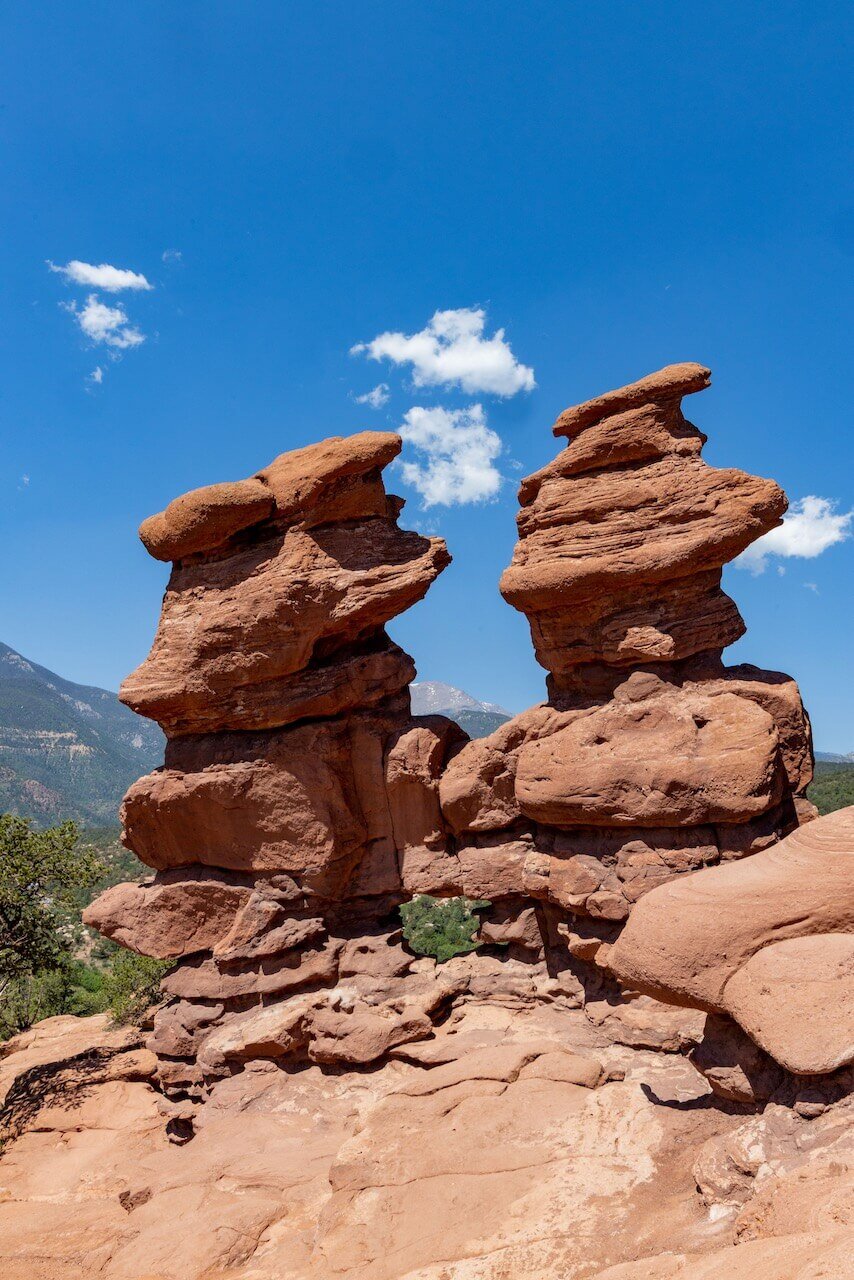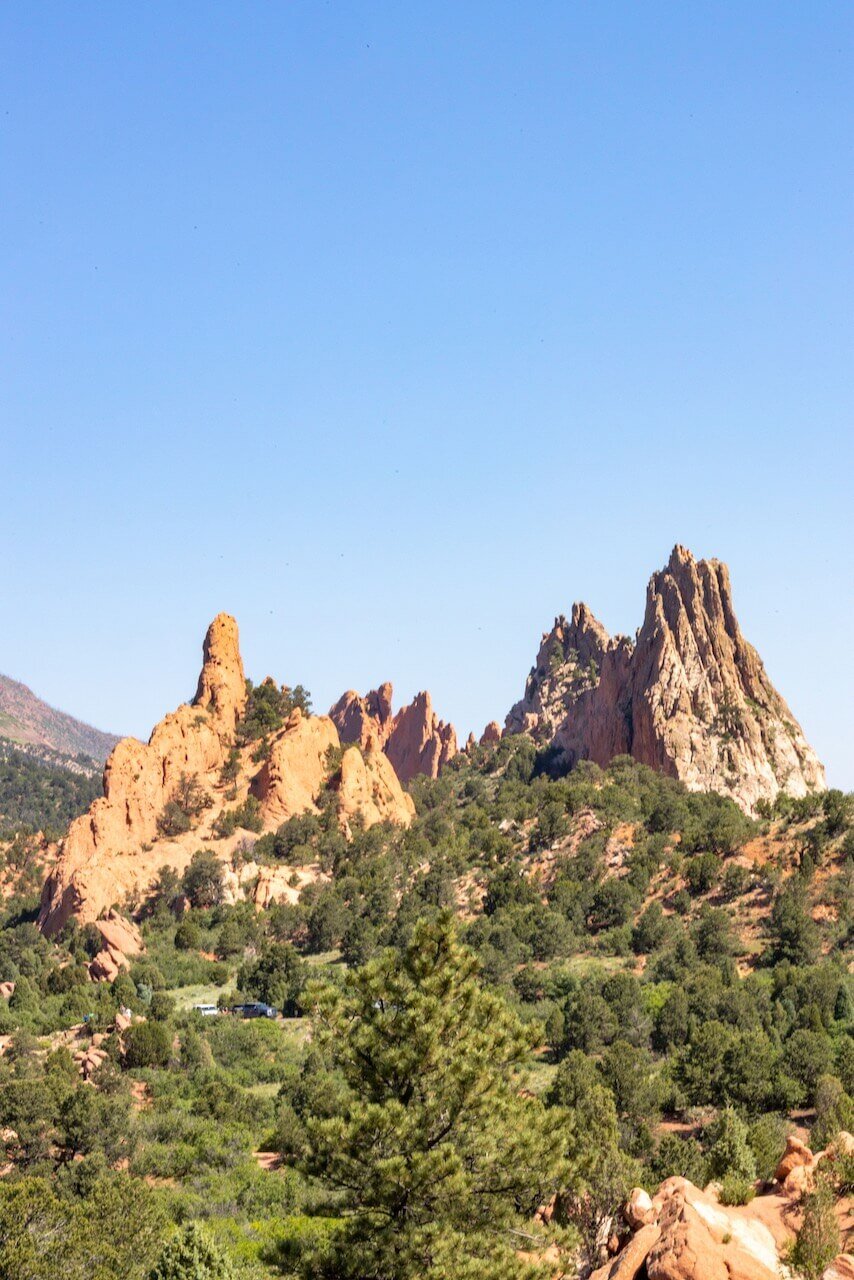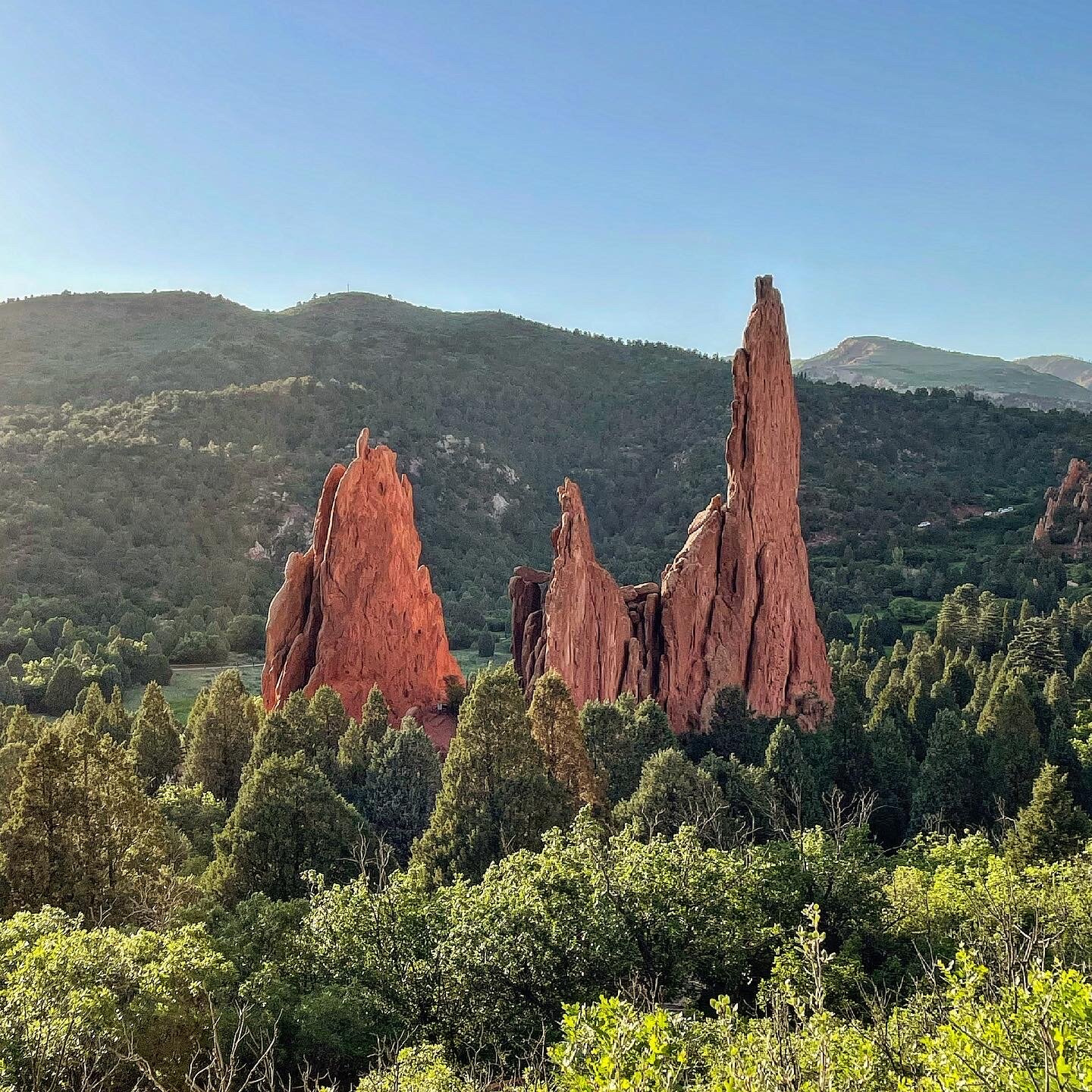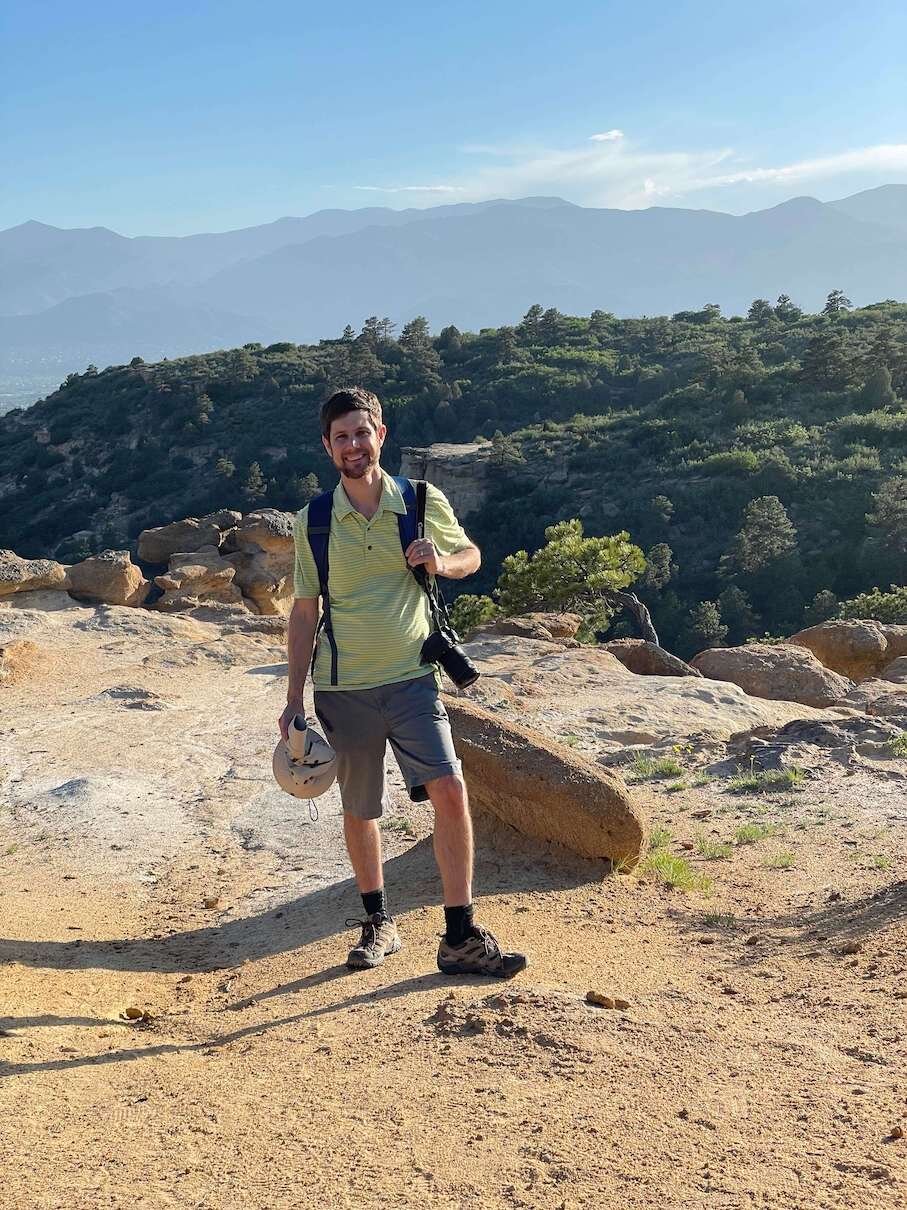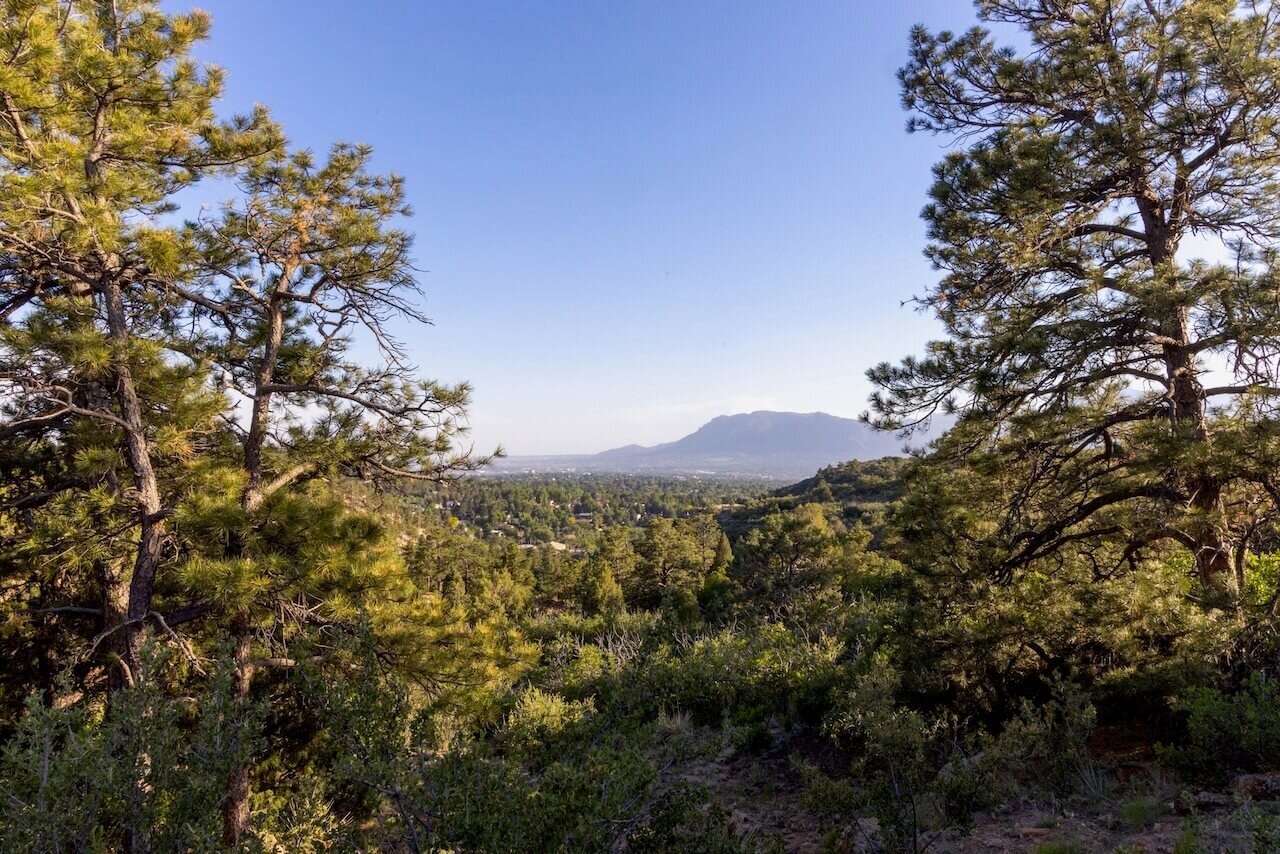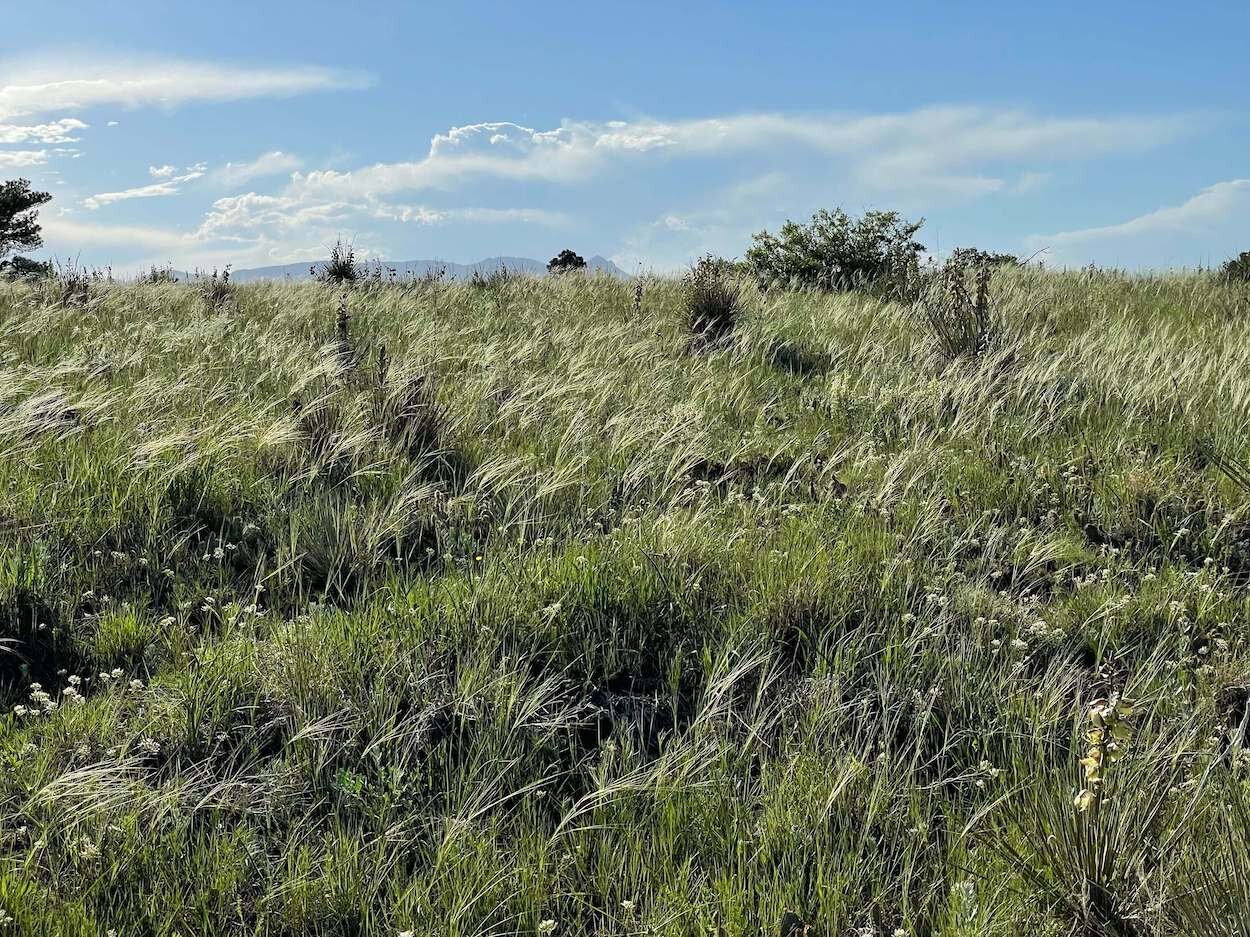Vacation on the Rocks: 15 Outdoor Adventures in Colorado Springs
Where to Climb, Trek, Wander, Hike, Eat, and Relax along the Front Range of the Rockies in Southern Colorado.
By Amy Beth and Derek Wright
How to Get There:
Colorado Springs is the second largest town in Colorado, roughly seventy miles south of Denver and nestled in the Front Range of the Rockies. It’s a laid back and ultra-accessible town, where the nights are cool and the altitude is moderate. The rocky landscape formed millions of years ago and has been changing ever since. There are so many places to adventure in and explore this landscape—regional and city parks, Pike National Forest, National Monuments, Interpretative Parks, and more.
The City of Colorado Springs Municipal Airport (COS), located on the east side of the city, has daily flights from all major carriers, with the most options from American, Southwest, and Frontier airlines. Denver International Airport (DEN) is roughly a 1.5 hour drive to the north, and simply has a massive amount of flight options. However, getting into and out of the busy Denver airport can take an additional hour of time.
If driving, Colorado Springs is conveniently located by major interstates (I-70, I-25) and is easy to reach.
Where to Stay:
Marriott Colorado Springs, with Pikes Peak in the distance, photo by Derek Wright.
The Marriott Colorado Springs is positioned for striking views of the mountains and a stellar view of Pike’s Peak, which becomes a point of reference and a home-base anchor throughout the visit. Aspiring photographers can wake early to capture sunrises and linger at the hotel pool during sunset, the changes in color and sky in close relief on the immediate horizon.
The rooms themselves are spacious, with artful modern design. Before dinner, take a dip in the pool and chat with fellow travelers about their adventures—their hikes, vistas, summits, climbs, treks, and more. Thanks for hosting us!
Locally, the dining scene is diverse, with restaurants that are part of Old Colorado City, a foothold of early tourism in the area, as well as many cool contemporary options with a quality that rivals many western towns. We have included some of our favorites at the bottom of this post.
Marriott Colorado Springs, “a room with a view” (of Pikes Peak!) photo by Derek Wright.
Be sure to spend an evening watching the sunset over the mountains as you mingle with fellow adventurers in the hotel lounge. Consider waking early for a sunrise hike on the Black and Blue Loop Trail behind the hotel, (part of Ute Valley Regional Park). In late afternoon, lounge in one of many stately comfy chairs in the lobby where you can dust off your hiking shoes for the next adventure…
I. Garden of the Gods
Its astonishing that Garden of the Gods is a free city park, as it’s massive sandstone monoliths form a gargantuan sculpture garden that reflects more than 300 million years of geologic change. The park is a marvel of geologic wonders sculpted by erosion, much like Arches and Canyonlands, and each formation is grand and distinct.
This is an especially nice destination for the first day in town, as many of the trails are paved, accessible, and easy to moderate. Its also magical at all times of day—we particularly enjoyed visiting at dusk, when families are preparing for dinner and it’s less crowded, and the temperature cools. Beautiful sunset views can be found near Sleeping Giant, on the Mesa Overlook Trail, and throughout the park at dusk. The sun falls behind a sweeping view of the mountains. Be mindful of park rules and don’t ascend more than 10 feet high onto any rock or feature without a climbing permit. At the visitors center, a marvelous exhibition offers grounding on how the park formed and its history as a destination for visitors to the area, including a look at a preserved family homestead, Rock Ledge Ranch, from the late 19th century.
II. Ute Valley Park
Ute Valley Park, photo by Derek Wright.
Right behind the hotel, a quick downhill links you to an amazing moderately-challenging loop hike (the trail is called the Black and Blue Loop), winding through Ute Valley Park, one of Colorado Springs’ 15 surprising regional parks (you will see a few others pop up on this list!). We say “surprising,” because each of these parks has a similar history and majesty as many of America’s iconic and magisterial national parks. This hike, similar to Red Rock Canyon Open Space (more on that below), offers views of hogback formations, longer outcroppings of rock that have been pushed upward and eroded. This hike is a great way to get your bearings and acclimate to the altitude while enjoying the mountain scenery, air, sprouting wildflowers.
If you have mountain bike experience, this trails system is a great option, and the hotel offers bicycles and helmets for use. Keep an eye out for deer! Trail running is a great option as well.
Ute Valley Park, photo by Derek Wright.
You can also access this and other trails via the Vindicator Drive entrance, by car. The park has so many ways to explore and includes a natural sandstone arch that is roughly 10 feet tall.
III. Palmer Park
A mesa above the city, the trails at Palmer Park are mostly level, with incredible views of Colorado Springs on all sides, along the rim. A few challenging trails, like the four-mile Templeton Trail, start at the bottom of the large mesa and wind to the top. The drive to the top is also very beautiful, and the birdseye views of the city offer new perspective. At sunrise and sunset, the sun scrapes the Front Range and dramatic rays of light radiate from behind the Rockies, giving you a sunset to remember (and photograph!) One seasonal travel tip is to visit the Yucca Trail in June, when the yucca are flowering. This crisscrosses the Mesa Trail, for a serene, secluded, and meditative wander atop of the city.
IV. North Cheyenne Cañon Regional Park
Views of Pike National Forest, photo by Amy Beth Wright.
This park is on the eastern edge of Pike National Forest. There are a few wonderful trails here, but let’s mention right off the bat that the forest is astonishingly beautiful—its depth and immensity is immediate and massive.
Helen Hunt Falls, photo by Amy Beth Wright.
The Seven Bridges Trail is a satisfying hike, roughly 3.7 miles long and moderately easy. And, you can always stop before the seventh bridge, as the trail is beautiful throughout. The towering mountains of Pike National Forest nestle you in the forest, but there’s not much elevation gain at all; it’s a slow, steady, and gradual uphill, and then downhill under shaded forest canopy. The temperature difference en route to the trailhead (from the parking lot) versus the temperature on the trail itself was noticeable. Note that the trailhead is an abrupt right about ¼ mile from the parking lot, toward a sign that says “622.” As its Forest Service land, there’s not a lot of markings other than the official numbered signs.
Per its name, this trail takes you over seven footbridges crossing the North Cheyenne Creek as it rushes down the mountainside. In late spring and early summer, the water is really coursing due to the snowmelt, and the sound of trickling or rushing water often accompanies the hike. Several small waterfalls intersect with the trail for idyllic photo opportunities, and the mix of conifers and deciduous trees adds to the beauty. We love this hike, it’s a great way to spend several enriching hours tucked in the forest while also being an adventure, in traversing all seven bridges. The parking area can get busy, so if a weekday visit is possible, that is recommended. Or, arrive closer to the end of the day.
Stop at Helen Hunt Falls before or after, accessed 2.5 miles along North Cheyenne Canyon Road from the park entrance. It’s a scenic stop, even if you are only able to see the falls from the parking lot (parking is a little tight here as well!). From here, be sure to take the Silver Cascade Trail, which is just 1/3 of mile with an elevation gain of 200 feet, ending in a beautiful view of the canyon and Front Range.
View from Bridge #3, Seven Bridges Trail, photo by Derek Wright.
V. Manitou Springs
This is a nostalgic, walkable, and popular western town known for its flowing natural mineral springs, each with their own level of effervescence and flavor. Bring a water bottle, so you can taste and compare for free. The town maintains fonts for each of the eight local springs, like water fountains—just stick your water bottle under the flowing spigot. The underlying rock makes these springs unique, as there many caverns and caves where the water pools and dissolves the rock; eventually, pressure forces the water upward and into the springs. To explore, park the car at one of the three municipal lots (metered parking) along the Manitou Avenue; 7- Minute Spring, the first spring on the self-guided walking tour along Manitou Avenue, is best accessed via the Hiawatha Gardens parking lot. In the summer, there is free parking available at Fields Park, where you can pick up the free shuttle (Bus #36) to downtown. Plan your visit with this helpful link.
Manitou Springs Penny Arcade, photo by Derek Wright.
People have flocked to Manitou Springs for centuries. In the last 30 to 40 years, both the springs and the town have resurged in popularity, especially as mineral waters have also grown in popularity as a late 20th century beverage. The town is a great place to spend a nice half-day after a hike, or for leisure time in the mountains. A very fun penny arcade, across from a carnival picnic pavilion (where Cheyenne Spring is surreptitiously located, keep an eye out against the wall) is a great place to spend a roll of quarters on vintage pinball and video games, many of which are original and in working order. Ice cream is a popular stop, at the Colorado Custard Company and Pike’s Peak Chocolate and Ice Cream. The town is reminiscent of mountain escapes from both the 21st and 20th centuries, with modern shops and conveniences and the vibe and fun of a 1920s summer vacation hot spot. Try the pancakes at Uncle Sam’s on the way in!
VI. Manitou Incline
For a great workout along the side of a mountain, check out the Manitou Incline. Read the guidelines here, before deciding if this hike is for you, as it’s strenuous. Reservations are required. This trail is built literally over the railroad ties (tracks that have been ripped up) of an old cog railroad train, like the one that goes to the top of Pikes Peak. The climb is 2,744 stairs with 2,000 feet in elevation gain at an average of 40% grade. It’s consistent, very steep, about a mile up, and will take you around 1-2 hours depending on your fitness.
Hikers aren’t permitted to go down the incline. Instead, they will use the Barr Trail (which, when going uphill, ends at nearby Pikes Peak) to slowly wind back down to Manitou over a lovely four miles of trail.
Parking can be tricky. Visit the link above to see where nearby parking lots are located, but also consider the free Manitou Springs shuttle, which stops close to the trailhead.
VII. Pikes Peak
One view from atop Pikes Peak, photo by Derek Wright.
Overlooking Colorado Springs, Pikes Peak is a fixture on the local skyline, a touchstone landmark. The land in southern Colorado is vast, ancient, and scenic, and Pike’s Peak is a constant reminder of that—its long story makes for an interesting juxtaposition with contemporary life, and is part of what makes Colorado Springs so unique. With the right light (and maybe a zoom lens), you can often see the visitor center “peeking” out on the side of the mountain. The mountain itself is a National Historic Landmark, made of granite that is more than one billion years old. The weaker rocks have eroded, giving us the peak we see today.
Pike’s Peak is one of the 96 mountains in the U.S. West that are known as “Fourteeners,” (reaching a height of 14,000 feet or more). From the top, you can see the expansive Rocky Mountain chain, and look north to the skiing centers of Colorado and down into the valley from where you drove, the city and the plains inching to the horizon. Later, in your photos, notice how you can see the curvature of the earth, also on the horizon line.
The journey up is in itself an adventure and a 200-year-old tradition. In the 1890s, the journey was by mule and horse wagons; travelers would sleep in the wagon seats overnight to assure themselves of a place on board when the wagon departed up the mountain the morning. Now, plan on just three to four hours to enjoy the peak and safely drive both up and down! It’s one of the most accessible mountaintops in the U.S., and certainly one of the highest.
Looking down from Pikes Peak, photo by Amy Beth Wright.
Glen Cove Inn, midway up the mountain, is a good place to stop for food and souvenirs, and watch out (reportedly) for a ghost that haunts the place! On the way down or up, the Catamounts, lowland lakes set idyllically against the backdrop of the mountain, are a great place to relax. The access point is a dirt road, and so a high clearance vehicle is very effective here, though we saw sedans safely driving this road. Many locals will have a yearly pass and will bring kayaks to enjoy this part of the forest.
View of Pikes Peak and Pike National Forest, photo by Derek Wright.
Also stop at Devil’s Playground at the 16 mile marker, for more expansive views and a great place to get photos of the summit.
Fun fact: Driving up the mountain is also a racing motorist’s dream. The annual Pikes Peak International Hill Climb is a race to the top of the peak in late June every year, and is the second oldest race in the U.S. Imagine hitting speeds up to 130 miles an hour with quick braking on the turns! The racers take turns, and the fastest time at the end of the day wins the honors.
The Pikes Peak Cog Railway is also an option for arriving at the summit. Reservations are required.
VIII. Cave of the Winds Mountain Park
This attraction features dry caves, where you can more so see why the local springs here are mineral-rich. Two guided tours are offered, a Discovery Tour suitable for most, and a Lantern Tour, “for those who want something more daring and spooky.” Above ground recreation includes a zip line and 200-foot plunge ride into the canyon (additional fees required). Plan your visit here: https://caveofthewinds.com/
IX. Red Rock Canyon Open Space
Red Rock Canyon trails, with Garden of the Gods in the distance, photo by Amy Beth Wright.
This old sandstone mining area features awesome views of Pike’s Peak (you can see the visitor center!), Garden of the Gods, and the surrounding city. Miles of relatively easy trails take you into the stunning red rock areas and through a section of an old quarry, out of use since the 1890s. Dramatic, jagged cuts, inclines, and depressions define the rocky landscape around the quarry. The sandstone quarried here was world famous, and some buildings in Denver and other cities out west still feature the blocks. The park exists as pieced together by the Bock family in the mid-twentieth century, as their home and later sold to the city of Colorado Springs. Irrigation elements and property from the Bock era are preserved as part of the historical landscape, for interpretation. Signs indicate that you can see fossils, and the area is popular with rock climbers, from novice to beginner.
Another section of Red Rock adjoins Bear Creek Regional Park; we enjoyed the Stephanie Trail, which ascends to an overlook of the city. It’s an easy hike, but beautiful, particularly at sunset. Several trails weave through the area, with trailheads to more advanced hikes like the Palmer and Bear Creek trails.
View of Colorado Springs from the Stephanie Trail, Bear Creek Regional Park, photo by Derek Wright.
X. Old Colorado City
This is a walkable and historic part of Colorado Springs, with several businesses, restaurants, bars, cafés, and art galleries in historic buildings from the 19th century. Parking is available, and the strip is not far from Garden of the Gods. We enjoyed dinner at Dat’s Italian and browsing the local galleries, as well as the nostalgic atmosphere.
XI. Florissant Fossil Beds National Monument
Fossilized redwood tree trunks, Florissant Fossil Beds, photo by Derek Wright.
Slightly further afield, (roughly a 20 minute drive from Woodland Park, Colorado, and an hour and a half from Pike’s Peak) is a rather amazing and relatively under-explored National Park Service site, Florissant Fossil Beds. This site preserves and interprets several massive fossilized redwood tree trunks from millions of years ago (when Colorado’s weather was more like northern California’s today!). The site was once a river, but ash from a nearby volcano trapped these tree trunks and other flora and thousands of other fossils, including perfectly preserved insects from 30 million years ago, in time. Spend time in the visitor center, and hiking the Petrified Forest Loop trail just behind it, to appreciate the scale of preservation here. The site is still being studied by paleontologists today; you might even see an active dig, with scientists on site who can answer questions. There are roughly 14 miles of easy to moderate trails that crisscross the park, and it’s a perfect way to explore and enjoy a summer afternoon.
XII. Woodland Park
Views of Pike’s Peak dominate this mountain town, which is home to the Rocky Mountain Dinosaur Research Center, and several restaurants and local businesses. This is the largest town in the upper mountain vicinity. You’ll be able to find food, supplies, gas and other essentials as you continue your day trip through the Pike’s Peak area. The Donut Mill is a great place to grab a coffee or some delicious doughnuts or fritters (the maple bacon is a hard act to follow) for breakfast or lunch, if you arrive early enough.
XIII. National Forest Service Road 300
This is a true Rocky Mountain adventure. This rugged, dirt road runs between the towns of Woodland Park and Colorado Springs. One might be a bit wary of Forest Service roads, which can be a mixed bag—but fear not, this is a well-maintained road. It winds through the Front Range in Pike National Forest, and driving down or up is an unforgettable way to explore the forest and the Rocky Mountains; the views are extraordinary, and the experience parallels, at moments, driving Going to the Sun Road at Glacier.
On Forest Service Road 300, Pike National Forest, photo by Derek Wright.
There are just a few pull-offs, and they deliver grand views of the Ute Valley, Pike’s Peak, the city of Colorado Springs, and toward the horizon, the start of the Great Plains. A high-clearance 4-wheel-drive vehicle is again ideal, but we spied several sedans as well. We wouldn’t recommend driving down Pikes Peak and then traversing FS Road 300—give your brakes a break, and spread things out a bit. And do use lower gear as much as possible when descending mountain roads. A bit of caution, the road isn’t paved but is graded, so this is not recommended during rainy periods due to mud. Some turns and passages are less than two lanes wide, so take it slow in case someone approaches from the opposite direction.
The beauty and quiet of the forest can be deeply appreciated on this drive, which is quite a contrast to the bustle of Highway 24. One section of the road passes by places burned by devastating wildfires in 2012, a reminder of how much the forest has rebounded, and a reminder that decades of regrowth are necessary for forest restoration. This epic road trip ends at the Garden of the Gods, offering a rare view of the park as you approach from the northwest.
Before heading out, double check Pike National Forest’s website to be sure the road is open for travel, and download an offline map for safety, as cell phone service is spotty.
Cloudscapes and epic Rocky Mountain views along Forest Service Road 300, photo by Amy Beth Wright.
XIV. Paint Mines Interpretive Park
This extraordinary adventure is in the middle of Colorado’s high prairie, to the east. It’s a county park with some really amazing geologic features. Oxidized iron compounds have formed beautiful colors within the clays here, and many of the formations are similar in color to those found in Utah parks; here, the trails take you right into the hoodoos, and the features tower over you as you walk though the brilliant whites, yellows, pinks, reds. This is about 40 minutes east of Colorado Springs, via Route 24, and is a must-see park that is right off the road. The otherworldly location feels out of joint in the middle of the high prairie. There are easy trails for all ages, but minimal shade, so on a hot day be sure to pack sunscreen and water.
Paint Mines Interpretive Park, photo by Derek Wright.
XV. Local Dining
Award-winning sage and sausage biscuits and gravy at the Urban Egg, photo by Derek Wright.
The University Park Shopping Center is just a few miles from the hotel, and some of our favorite very local eateries were found here, like ice cream at Blue Mountain Creamery, pizza at Il Vicino, and brunch or lunch at the Urban Egg. A few other local favorites include Salsa on the Rock, the very casual but very tasty Piglatin Cocina, Barbecue Heaven, Caspian Cafe for Mediterranean fare, and Alchemy Irish Pub. The Guinness Pie at Wyatt’s Pub is not to be missed. Eidelweiss, a German restaurant, is another local fave! Bon appetit! And, happy trails!





